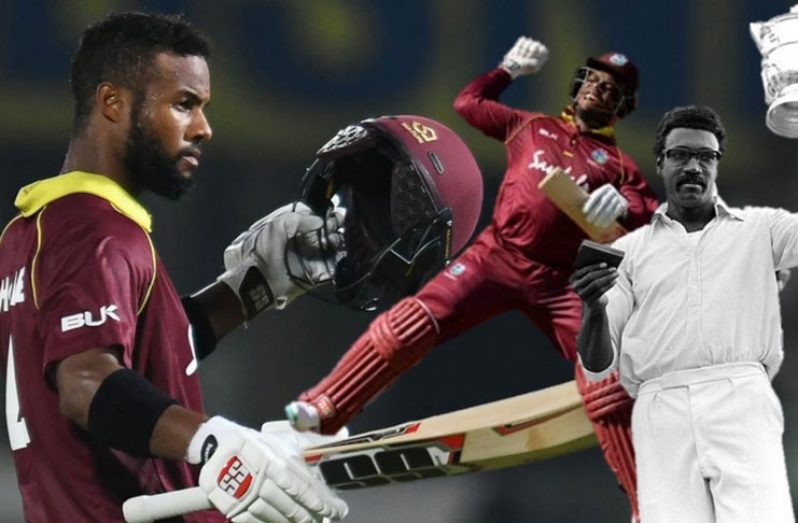By Ben Gardner for the ICC, June 3, 2019
IN Shimron Hetmyer and Shai Hope, West Indies possess two batting talents that have the potential to light up the ICC Men’s Cricket World Cup.
Nevertheless, beware of the easy categorisation. Hetmyer is a left-hander seemingly set in the exuberant Guyanese tradition of Clive Lloyd and Rohan Kanhai. He has a midwicket flick to die for and dances down the track regardless of the format, without a care in the world.
According to CricViz, he plays attacking shots almost twice as often as is the norm in Test cricket. But when you ask him if he sees his role as to take the game to the opposition, he disagrees.
“At times I can pick up the scoring,” he tells the ICC. “But I don’t really see myself as an attacking batsman. I see myself as a batsman who could pick up the scoring whenever he wants I guess. For me, it is mainly on feelings. I would say I would mainly do that when I am starting to feel a little more comfortable in a match situation or when I am feeling comfortable about myself.”
Hetmyer, 22 years old, 16 ODIs young, and four tons to his name already, is just one of a crop of fast-scoring young Caribbean batsmen ready to light up this Men’s Cricket World Cup, with captain Jason Holder also citing Evin Lewis and Nicholas Pooran as potential match-winners.
But though he’s only 25, and, with six hundreds since the start of October, possibly the most in-form batsman in the world, Hope doesn’t quite fit in their mould. In many ways he’s already a senior player acting as the foil for his more destructive team-mates. Again however, while Hope admits he’s become his team’s “anchor”, he insists it’s due to necessity rather than nature.
“It’s probably more my role to keep the innings together and give us that impetus going into the back of the innings, but it’s about playing the situation of the game,” he says. “I see myself as a guy who can adapt. Regardless of the situation, I think I can play whatever role is required. I’m more of a stroke-maker who plays classical shots.”
Still the symbolism is so good you’d almost wince were it written into a sports film. First there’s Hope, the buttoned-up paradigm of responsibility, the top-most fastener staying firmly in place even when carving out an unbeaten 123 in a tie against India in the Visag heat.
And in stark contrast is Hetmyer, the floppy-hatted free spirit, his headgear sending Twitter into a flurry of heart eyes emojis whenever he puts it on. He’s well aware of his fan club, but insists the sartorial choice originally came about due to function, not form.
“It was something that I picked up mainly in the nets. In the Caribbean the sun is pretty hot so one day I just stepped out, I was batting against spin, and I said, ‘Well because of how hot the sun is I will just try out a floppy and just see how it feels’.
“For a little bit it was feeling a bit uncomfortable because it wasn’t something I was accustomed to. The first game I used it was a tour match when Bangladesh came to the Caribbean just before the Test series and I actually scored a hundred and from then on I just kept on using it.”
The look of the headgear, as well as the luck, soon grew on him.
“It is mainly for the sun,” he insists. “But I do like how it looks actually. I actually had a photo of me wearing it as the wallpaper on my phone the other day.”
The reaction from fans around the world is worth exploring, because, as good as Hetmyer looks, there’s something else at play; the adoration is as much about the great West Indian batsmen who have gone before as it is about the potential one right in front of them.
“Looking at some of the older cricket matches and some of the older guys from the past I have seen that most of them use the floppy hat,” says Hetmyer. “Me, using it now, it is actually bringing back something from the old days for the people of the Caribbean and for the people of the international cricket world. I think that is probably another reason why most people, they go towards looking at it that much.”
Dealing with the weight of that expectation of playing in the shadow of the side in the 70s and 80s that won the first two men’s World Cups and went 29 Test series without defeat is tough, especially as a young player trying to make his way, but also part of the job.
“Everyone continuously tells me that I am a young person coming up in the team so I just try as much as possible to just be here and be in the moment and to gain as much experience as I can whatever way possible,” says Hetmyer. “You have to remember you are one person and you can’t be someone else and it is all about you just being yourself playing the cricket you know and love.”
“You must be proud, growing up as a West Indian and seeing what they’ve done in the past, knowing that you could be a part of it and even contribute to some of those things,” adds Hope. “I’m sure any West Indies cricketer can say the same; seeing those guys on TV, hearing them on the radio, and having the opportunity to do those things that they did, means a lot. But times change and things evolve. So you need to balance knowing the history and then playing for your own history.”
finest hour as an international cricketer to date came at Headingley in 2017, in a Test against England which the Windies came into on the back of an innings-and-209 run thumping, and left resurgent, the Bajan’s twin tons underscoring a famous victory.
“That was years ago,” he says. “That’s how I feel about it. It’s a good memory to have in your bank, but it’s long gone. I have to create more moments, more memories.”
Now, West Indies and Hope have the chance to. It wasn’t long ago they were on the brink of not even qualifying for the Men’s Cricket World Cup, having to come through a Qualifier fraught with danger.
Since then, the reintegration of some of their more experienced players and the blossoming of a crop of youngsters – aside from the batsmen, canny left-armer Sheldon Cottrell and right-arm speedster Oshane Thomas give their bowling attack variety and firepower – have made them many pundits’ dark horses for the tournament.
February’s 2-2 series draw with England – the only time in 11 bilateral series the tournament hosts and favourites had failed to win outright – underlined their intent. The pieces might just be falling into place for the West Indies to secure a first title since 1979.
“It would mean everything,” says Hope. “Especially coming through the qualifiers. You lose two games and you’re out, so we had to work so hard. There were some instances in the back of our head that if we did muck up, we’d be watching on TV. We knew if we had two bad games, that was it; it was a do-or-die situation. To come from there and see ourselves at Lord’s lifting the trophy would mean the world. Especially to me; I always wanted to play in a World Cup for the West Indies. It would be achieving a lifelong goal.”
Childhood dreams achieved, and on their own terms, neither ignoring nor beholden to the past. It would be some story, and thrillingly, it’s in West Indies’ own hands.



.jpg)








